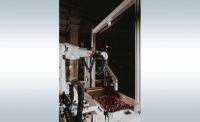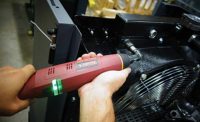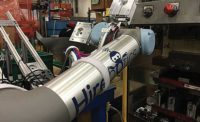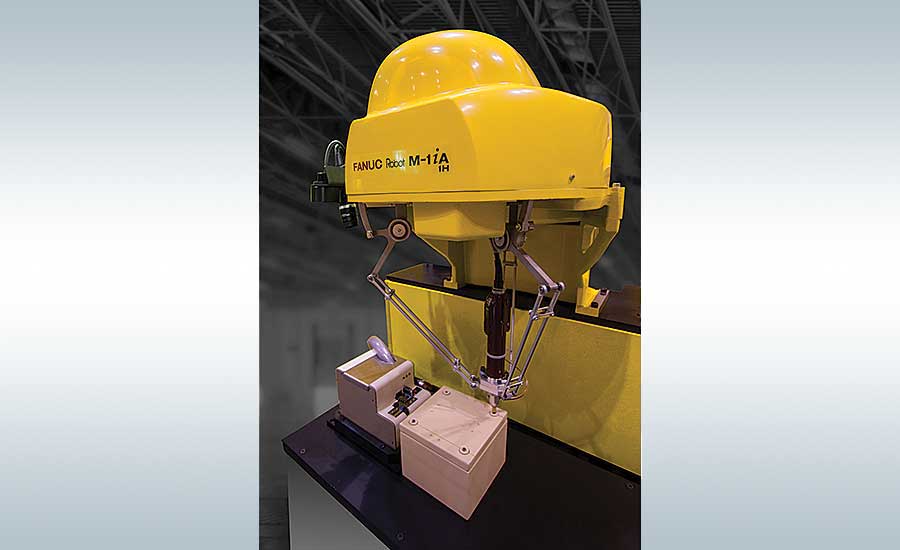Robotic Screwdriving Comes of Age
New technology makes it easier to automate fastening applications






Traditionally, assemblers use semiautomated or manual tools to drive screws. While that technology is still used for some fastening applications, more manufacturers are investing in robotic screwdriving.
Today, robots are less expensive than in the past and more readily accessible to smaller manufacturers. Robotic screwdriving is ideal for assembly applications that require high torque, multiple fasteners, quick changeover and high-mix production.
Automated screwdriver suppliers, such as ASG, DEPRAG, Visumatic and Weber, have tools that can mount onto the arms of traditional robots ranging from SCARA to six-axis machines. Some of those companies have also recently developed equipment that can be used with collaborative robots.
“Robots allow a greater degree of consistency than traditional handheld screwdriving systems,” says Brandt Ruszkiewicz, Ph.D., lead development engineer at Semblex Corp., a leading manufacturer of fasteners. “They will always move to the same location and drive the screw with the same parameters, leading to greater repeatability than a human can offer.
“Robots do not get tired and they do not take breaks,” notes Ruszkiewicz. “This allows for consistent driving around the clock. In addition, robots have more flexibility than fixed screwdriving; a single robot can move to multiple areas to drive screws.”
Ruszkiewicz says it’s important for engineers to remember that robotic screwdriving is different from more traditional applications, such as fixed or handheld screwdriving. “It’s more consistent and can be run faster than handheld driving, due to the increased strength and repeatability of the robot,” he points out.
“However, robotic screwdriving does not do well with part misalignment or poor quality fasteners,” warns Ruszkiewicz. “Most robotic systems will not adjust for variation in the parts they join.”
“The main advantage of using a robot in the screwdriving process is ergonomics,” adds Flo Acuna, technical account manager at KUKA. “Other benefits include repeatability and accountability that all screws are fastened.”
Multiple Benefits
Until recently, robotic screwdriving was typically associated with large fasteners used to assemble automotive subassemblies, such as chassis and power trains. But, the technology is now increasingly being used with small screws in many other types of assembly applications.
“The electronics industry is driving demand for robotic screwdriving today, due to the constant production of new and improved products,” says Samir Patel, director of product and applications engineering at Kawasaki Robotics USA Inc.
“Most high-volume portable electronics, such as smartphones, typically require some fastening applications for handling small screws that range in size from 1.2 to 3 millimeters,” explains Patel. “New tools equipped with error detection devices and data traceability functions appeal to these manufacturers.”
“Consumer product manufacturers and contract manufacturers have been increasing their use of robotics,” adds Chris Blanchette, executive director for global accounts at FANUC America Corp. “Many of those processes have assemblies that rely on screws to enhance serviceability.
“Automation is ideal for handling products that use smaller screws and smaller assemblies,” explains Blanchette. “Robotic screwdriving offers more reliability in the assembly process and removes people from unsafe or challenging operations.”
“The No. 1 factor behind growing interest in robotic screwdriving is the increasing cost of labor,” says Stephen Rowell, sales director for Canada at Weber Screwdriving Systems Inc. “Today, it’s becoming easier to justify the cost of a robot. Robots are safer, easier to program and easier to integrate than they ever have been.
“People are prone to productivity swings at different times of the day,” notes Rowell. “Robots, on the other hand, run at 100 percent efficiency all day. They also have much more consistent cycle rates. However, humans are typically more adaptable and flexible; they can easily adjust to slight product changes or slightly imperfect parts.”
Quick changeover is another reason why robots are often more flexible than traditional fixed automation. As product life cycles continue getting shorter and shorter, that’s becoming a critical factor for engineers to consider.
“Speed is the biggest advantage of robotic screwdriving, and accuracy is close behind,” says Ryan Guthrie, executive vice president of TM Robotics (Americas) Inc. “With automation, there’s no fumbling around getting a screw thread lined up with the driver. Everything is fixtured and repeatable.
“The cost of robotic screwdriving has decreased dramatically in recent years,” notes Guthrie. “Within the last 10 years, the cost of most robots has dropped 20 percent to 30 percent.”
“Because of that, we’ve seen smaller manufacturers take on automation projects that would have been uneconomical five years ago,” adds Nigel Smith, CEO of TM Robotics. His company recently partnered with ASG, division of Jergens Inc., to provide a full turnkey system that includes SCARA and six-axis robots equipped with state-of-the-art screwdriving technology.
“Advanced screwdrivers are more available, more capable and more cost-effective today,” says Nicolas De Keijser, assembly and test business line manager at ABB Robotics. That’s why its dual-armed YuMi collaborative machine has come popular for screwdriving applications in the electronics industry.
ABB also recently partnered with Atlas Copco on a new robotic screwdriving system that will be officially launched at the Automate Show in Chicago in April. The easy-to-program device will feature a screwdriver and a software package integrated together. It will be able to operate with several different types of robots, including both six-axis and collaborative machines.
Numerous Options
Jarrod Neff, marketing manager at Visumatic Industrial Products Inc., says there has been a growing interest in robotic screwdriving during the last few years. “Lately, there hasn’t been as much demand for traditional hand-operated units,” he claims.
“Robotic screwdriving gives you more control over your process,” says Neff. “A robot knows that it put the right screw in the right spot, and it can document that each screw was installed at the right torque and the right depth. Unlike a human operator, a robot will tell on itself without getting scared, because it knows that it's not going to get yelled at.”
“Robots can drive screws from all directions, sometimes with varying torque requirements,” adds Olivier Cremoux, robotics business development manager at Stäubli Corp. “They also have the ability to drive different sizes of screws using various feeders for each type of fastener. Manufacturers can achieve higher cycles per screwdriver spindle and faster cycle time per screw, while improving quality.”
Many types of robots can be used for screwdriving applications. Each has pros and cons that engineers must carefully consider.
SCARA robots are widely used for screwdriving applications, because they are very precise and can handle a lot of torque.
“SCARAs have a Z-axis built into the system,” says Neff. “That enables engineers to use tooling that’s usable with different parts with different heights. It’s easy to change the coordinates of the robot.”
Cartesian robots are ideal for applications where multiple screws are required on a single plane. They can typically handle more force than SCARA robots.
“The large footprint of Cartesians is good for large parts,” says Doug Wright, technical services manager at ASG. “They’re also less expensive than SCARA robots.”
Because they provide articulated motion, six-axis robots are ideal alternatives for many screwdriving applications. Unlike Cartesian robots, which have a rectilinear work envelope, or SCARAs, which have a cylindrical work envelope, six-axis robots have a spherical work envelope.
An articulated robot can reach above, below, around and behind itself. Its wrist can rotate a fastening tool or turn it on an angle. Six-axis robots offer agility and long reach, and they can handle complex part geometries.
When there are challenging applications where screws have to be inserted at odd angles or off plane, then six-axis machines are ideal. However, articulated robots are not as fast as Cartesians and SCARAs. They’re also more expensive.
“Six-axis robots can handle higher payloads and higher torque applications, such as fastening engine mounts or valve covers,” says Neff. “They can also handle odd angles, reach into vehicles and do a better job of mimicking the human arm-hand motion.”
Another option is delta robots. They’re popular for high-speed screwdriving applications that involve small screws.
“Speed is fantastic with delta robots,” explains Wright. “The drawback is the low payload capacity (typically less than 4 kilograms). You can use a delta robot for pick-and-place applications, but not for any application that requires screw feeding. End-of-arm tooling, including the driver and screwfeeder, can weigh 4 pounds or more.”
Collaborative Products
Collaborative robots are increasingly popular because they enable people and machines to work in close proximity. They appeal to a wide variety of manufacturers, since they are flexible, easy to use, and require little or no safety barriers.
“We’re seeing more applications today for collaborative robots,” says FANUC’s Blanchette. “They’re great for screwdriving tasks where cables or other parts need to be negotiated or positioned. Collaborative robots enable operators to assist in the assembly
operation, such as moving a motherboard cable out of the way.”
“There’s a lot of misunderstanding about what collaborative robotic assembly is,” adds Weber’s Rowell. “For instance, there’s a big difference between collaborative and cooperative processes.
“A true collaborative environment is where an operator is working on an assembly at the same time that the robot is,” claims Rowell. “The human may be holding a part or acting like a fixture. Or, the human may be inserting a pin while the robot is driving a screw.
“Most people who think that a process is collaborative are incorrect,” says Rowell. “It’s often either a sequential or a parallel process in which the human is not doing something with the robot on the same assembly.
“A lot of the tools that go on the end of a collaborative robot are not collaborative,” explains Rowell. “The robot itself is collaborative; it’s equipped with sensing devices that enable the machine to stop when it feels a certain force pressed against it. But, if the robot is carrying something that has a sharp edge and anything other than smooth, rounded surfaces, it’s no longer collaborative.”
Weber’s traditional SER driver is used on a variety of Cartesian, six-axis and SCARA robots. But, its newest product, the HRC screwdriving system, is designed for exclusive use on collaborative robots. It consists of a screwdriving spindle, automatic feed and an intelligent control unit.
The SEV-C features a smooth protective cover with no sharp edges that could injure a person who brushes up against it. In addition, the tip of the screwdriver has a protective sheath. A built-in sensor in the nosepiece stops the robot if it detects something in the way, such as a hand or fixture.
“It’s designed for unfenced collaboration between humans and robots,” explains Rowell. “Screwdriving processes are completed at the same time and in the same space.”
All hoses, feed systems and sensors are routed in a closed cable package. Clearly visible LED strips are installed on the side surfaces of the protective cover, indicating the system’s status and providing visual warning functions.
“Collaborative robots are easier to deploy, maintain and support than traditional machines,” says Visumatic’s Neff. “That’s taken away a lot of the barriers that intimidated smaller manufacturers in the past. For instance, there’s a lot less hardware required, such as safety guarding.
“However, there are limitations other than just slower speed,” explains Neff. “For instance, we tend to see smaller torque applications with collaborative robots, because payload is a limiting factor.
“You have to take into consideration not just the weight of the screwdriving tool, but also the amount of force that’s going to be applied across the joints,” Neff points out. “Otherwise, every so often you’re going to overload the joints, which will trip the built-in safety sensors.”
Visumatic recently launched the VCM-3X.2 collaborative robot module. It includes an automatic screwfeeder, drive system, skeleton robot program, and an end effector for mounting directly to the wrist of a collaborative robot, such as Universal Robots’ popular UR5 and UR10 arms.
The lightweight tooling allows the robot to move at maximum speed without sacrificing collaborative safeguards. It incorporates Visumatic’s field-proven bit-advance assembly with dual-powered motion for precise, controlled fastener installation.
Slide position sensors confirm advancement and retraction of the bit, reporting to the robot controller that it is OK to move when the bit reaches the home position. This ensures a repeatable joining operation.
“The system can typically be set up in less than four hours vs. four or more days for a traditional SCARA or six-axis robot,” claims Neff. “So far, the system has been well received by our customers, and it’s being used by both large and small manufacturers.
“One of the most recent modules we built was for a large appliance manufacturer that’s using the machine to assemble electronic controls for a dishwasher,” says Neff. “We’ve also shipped the screwdriving system to a sump pump manufacturer and a small automotive supplier that produces interior trim panels.”
“The two main advantages of collaborative robots are safety and ease of programming,” adds ASG’s Wright “However, they’re less accurate and slower than other types of robots that are commonly used for screwdriving applications, such as SCARA or six-axis machines.”
At the 2018 Assembly Show, ASG launched the X-PAQ SD2500 precision fastening system. It features a built-in screwfeeder and is easy to program. The product enables quick changeover and is ideal for high-mix, low-volume assembly applications.
“Most interest has come from the electronics industry for applications such as attaching printed circuit boards to housings,” says Wright. “It can be used with screws that have a head diameter as small as 4 millimeters.”
Looking for a reprint of this article?
From high-res PDFs to custom plaques, order your copy today!









